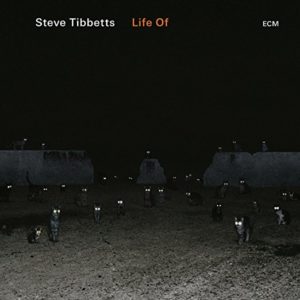The Guitar (1) – I have a Martin 12-string that my father gave to me. (…) It’s an old guitar, now. It has a peculiar internal resonance, as though it has a small concert hall inside of it. I try to bring that quality out by stringing the guitar in double courses. In other words, instead of stringing the 4 lower strings with octave courses, I string them in unison. It makes it a lot harder to play, but with double courses I can draw out overtones if I’m willing to really physically engage the strings.
The favourite guitarists? It’s not a discovery often made, no matter how much guitar music hits your ears. Neil Young, wizard – electric. Ralph Towner, wizard – acoustic. Yes. And when I heard Steve Tibbetts for the first time, it was a revelation: Northern Song (1981) followed by Safe Journey (1984). All those singular albums, among them Big Map Idea (1989) and The Fall Of Us All (1994).
I’ve been returning ever since. Always returning.
Tibbetts‘ albums only appear sporadically. You wait in anticipation for the next one. Some very interesting side projects pop up on other labels along the way, while in the meantime ECM always offer a kind of constant companionship. (It’s worth noting here that Northern Song was the only album produced by Manfred Eicher – no introduction necessary.)
A unique sound-world created from St. Paul, Minnesota. A guitar sound you recognise after seconds, never formula. The thrill comes from just listening, and letting go. And now, LIFE OF. Steve Tibbetts, Marc Anderson, Michelle Kinney, the inner circle. What made me quite so addicted to this music? Honestly I’ll never really know. This confession of not-knowing puts a bigger smile on my face than evocative pictures of distant worlds.
Michael Engelbrecht: Steve, at first, this photo with the turkeys … a walk through the woods?
Steve Tibbetts: This is my back yard in Minnesota.The turkeys arrive around 9 in the morning and cluster outside, gobbling. They are out there right now, talking to each other. There is a bird feeder above them, hanging off of a balcony, so they scratch around in the snow and leaves looking for bird food. The turkeys are quite tame, and they associate our bipedal primate family with food, so they sometimes come running and making sounds when they hear the back door open. Sometimes rival gangs of turkeys go to war in our back yard. It is really something to see and hear. At those time their raptor past is revealed.
Michael Engelbrecht: LIFE OF is vintage Tibbetts, all compositions are credited to you, I think, for the first time ever. It is more on the quiet side, like NATURAL CAUSES, but with its own darknesses and edges.
Steve Tibbetts: Yes, it’s of a piece with the last album. They’re relatives.
The Guitar (2) – The frets on my guitar are worn almost flat. There are some tiny intonation issues and places where strings buzz against frets. I took the twelve-string to Ron at St. Paul Guitar repair. He looked the guitar over. He picked up the guitar and sighted down the fretboard. He said, “The frets are flat. There might be some buzzing or intonation issues. Do you like the way it sounds?” I said, “I love the way it sounds.” He handed the guitar back over the counter to me and said, “Then I won’t fix it for you.”
Michael Engelbrecht: Looking at the titles, they seem like a collection of people from your life and times. What made you combine the pieces with certain names?
Steve Tibbetts: A lot of the songs have a similar feeling to them. I let them cross-pollinate. In order to more easily distinguish them I gave them names a few years ago, and I used the names of friends and family. Some of those names started influencing the music. It was a little spooky, but I played along with the process. Some names have more than one reference in my family. For instance, there are several women named „Alice,“ two named „Joel,“ and so on. One of the Joels died last year, another is still living. This sort of thing can give the music a peculiar resonance. „Half of ‚Joel‘ died,“ I might think to myself. This is typical of the managed insanity inherent in the artistic process. It is good to use any upwelling of meaning and emotion you can find, but you have to maintain due diligence and stay sane.
Michael Engelbrecht: „Life of Carol“ – is there a story?
Steve Tibbetts: No story, I’m afraid. It’s just another guitar circling, circling.
The Guitar (3) – I try to play the guitar for one or two hours before recording. Something needs warming up. Maybe the back of the twelve-string needs to be physically warmed up, or my fingertips need a certain pliability. At some point the guitar settles down and the little concert hall inside opens for business. I like the physicality of playing 12-string. I don’t use a pick. If I’m drifting off to sleep at night and feel my fingertips throbbing I know I had a good day.
Michael Engelbrecht: There‘s a kind of discreet tension between some more introspective moods, carefully developed dynamics – and the haunting picture on the cover with the „army of cats“.
Steve Tibbetts: Yes, just open up the back door at the right time of day and you’ll see turkeys and ghosts waiting and staring.
Michael Engelbrecht: Are you making use of meditation or other tools to stimulate creativity?
Steve Tibbetts: The process of creativity is really hard to talk about: where does creativity come from? How does artistic vision and inspiration arise? It is a nearly tangible experience when inspiration finally does come to visit, but it’s still very ephemeral and vapor-like. To go one step further and talk about a meditative influence on the creative process would be a bridge too far, I think. One can only speculate. An interesting thing however: sometimes an apparent spiritual or creative awakening is not at all meditative or serene in its manifestation. Look at „A Love Supreme“ or, especially, „The Inner Mounting Flame.“ There’s a kind of violence there that seems exactly right. Be leery of anyone who speaks with authority about practices of meditation and their impact on the creative process. Be afraid, be very afraid.
Michael Engelbrecht: The music seems to be more centered around sound and texture than around melodies, for example. It seems to circle around an invisible center …
Steve Tibbetts: Part of that is my being easily satisfied with circular musical logic. When I worked in Southeast Asia I got used to music that didn’t really go anywhere. It always folded back on itself and it seemed right that it did so. I wish I could compose a piece of music with real changes and progression but I don’t really know how to.
Michael Engelbrecht: Your love for your acoustic 12-string guitar is a life long affair. It is a familiar sound that never gets too familiar …
Steve Tibbetts: I remember an interview many years ago with Nana Vasconcelos where he talked about the berimbau which is, as you know, a 1-stringed instrument – a bow, a wire, a stick and a shaker. He said he found new sounds every day on the instrument. I feel the same way about this 12-string. There’s always something new, or something old that refines itself. I can’t take credit for a good sounding instrument.
Michael Engelbrecht: There‘ s such a special balance between the rhythmic parts of the music and the drone fields (of sampled sounds, Michelle‘s cello sounds etc.) Remember Miles Davis, in his electric period 69-75, also had, inside the whirlpool of energy, those stop-and-go passages inside the music. Of course it is a very distant parallel, but in your pieces here, one can also observe a lot of moments where the music seems to hold its breath, stand still, before moving on, and back again …
Steve Tibbetts: Yes, I have a copy of „Get Up With It“ at the studio; „Rated X.“ Badal Roy plays tabla. I think that may have been more Teo Maceo than Miles. It’s always special when a great artist works with a visionary producer.
Mixing – The small concert hall in the guitar encouraged me to seek out a large concert hall to mix the album in. The Macalaster College music department kindly let me bivouac in their concert hall for an evening. I set up two pairs of mics: one in the center of the hall, and one pair in back. It worked well to allow a room’s ambience to settle around the piano and percussion. The natural acoustics of the hall helped the guitar settle into the piano.
Michael Engelbrecht: Apropos piano, you have played that instrument on „Natural Causes“ for the first time. Was the reason for that to keep the spirit of the beginner awake who has, according to Zen teaching, at times more fresh choices than the highly virtuoso & professional „approach“?
Steve Tibbetts: I just wanted to be able to read music a little bit. I read a review of a book about Bach’s „Musical Offering.“ As I recall, the book titled „Evening In The Palace Of Reason“ concerns a challenge from the King of Prussia to Bach. The King presented Bach a theme, a melody, and tasked him with improvising a fugue from it. Bach took up the challenge and played a 3-voiced fugue. The King’s request to create a six-part fugue ex tempore could not be fulfilled by Bach, because the Royal Theme was too difficult for that. The „Musical Offering“ contains a 6-part fugue, elaborated on desk. When I read that, I thought, „Even if I saw the music I wouldn’t be able to understand what Bach had done.“ I wanted to understand. So I began studying with Susana Pinto and she taught me Bartok‘s „Mikrokosmos“ and Bach’s „Inventions.“
Michael Engelbrecht: I keep circling, too, a bit. Listening to „Life Of“ you can easily feel something brooding, some darkness, a certain twilight zone. Is the origin for these sensations unknown – or somehow graspable? Echoes from all those „stranger things“ you experienced in Asia?
Steve Tibbetts: There is sometimes a sort of credulous enthusiasm to believe in „stranger things“, as you say, especially in Asia. Nonetheless there does seem to be a certain permeability to the fabric of reality in some places in the world. A friend of mine called it „thinness.“ You can look for that in music and art as well. You listen and there is a quiet collapse of duality, self and other. This might sound terribly exotic or over-thought, but if you watch your mind when you listen to music you might witness a kind of melting.
Michael Engelbrecht: After all these years, you and the percussionist at your side, Marc Anderson, did develop a kind of „secret language“ in the studio, not always easy to understand for people you start working with. But Michele Kinney is long enough part of your „inner circle“, I think.
Steve Tibbetts: No secret codes. Michelle can make her cello sound like a distant electric guitar feeding back through a Marshall amp. Tony Iommi-style.
Michael Engelbrecht: Haha, echoes from Bach and Black Sabbath within a minute. Now, Steve, living in Minnesota: did you follow those cold winter chills that were part of the three seasons of „Fargo“ (I love them!), and the original movie by the Coen brothers? Do you have a favourite TV series at the moment?
Steve Tibbetts: Yes, there is definitely a Minnesota way of being that I have grown to love. Very Norwegian, taciturn, reserved. I moved here from Wisconsin in 1972 and this is my home now. I like the way people are here, and I like the devotion to arts, education, and the liberal politics of this state. Some great political figures have come from Minnesota: Al Franken, Hubert Humphrey, Walter Mondale, Eugene McCarthy, and especially Paul Wellstone. And, mhmm, Favorite TV series: politics and the Scandinavia mindset probably figure into my enjoyment of „Okkupert.“
Michael Engelbrecht: I know you have quite a big ECM collection. What was the last discovery or re-discovery inside the new or old ECM releases? I personally re-discovered that wonderful Shankar album „Vision“ with Jan Garbarek and Palle Mikkelborg. When I played it on air, the needle died a slow death and added weird distortions to Garbarek‘s high notes.
Steve Tibbetts: I don’t have to re-discover the first 300 albums in the ECM catalog; I’ve never really left them! I have „Dis“ on now, as I write this. Brooding, dark, just the way we like it.
Michael Engelbrecht: Wow – this is a lovely synchronicity. Yesterday, on the day you wrote this, I felt the urgent need to listen to an ancient ECM recording, I haven’t heard in years and that didn’t leave my turntable for weeks when it had been released deep in the last century. „Witchi-Tai-To“ from the Jan Garbarek-Bobo Stenson quartet. On the opening track, the Carla Bley-composition „Air“, his sopranino sounds sharp like a tool for cracking ice. Listening to that record now, I‘m still stunned, and not so much on memory lane. Thank you for sharing your thoughts, Steve!
The End – I still think in terms of albums, even in terms of album sides. I lined up the songs, left to right, and worked with the running order until it seemed to hang together or make some sort of story. I played the ending of every song with the beginning of every other song until a plot started to reveal itself (this is what happens when you work alone—musical plots reveal themselves). Here’s how it ends: The kids went to college. Their parents were sad for a little while, then fine. Ellen lived and is in remission. Grandma died. Grandpa was sad. Everyone else lived as happily ever after as could be expected.
The End (2) – The texts about the guitar, the mixing process, and „the end“ were taken from Steve Tibbetts’ Life Of-page. Steve’s landscape photo belongs to the „thin places of the world“ he’s talking about, and is from Ramagrama, near Lumbini, 2015. This assembly is a truely manafonistic work: thanks to „Joey“ Siemer for fighting the devil in the details, and his sensitive, delicate and tactful design that allows linear and non-linear reading. Thanks to Ian McCartney for giving my small introduction the right groove and sharpness. Thanks to my late English teacher Dr. Egon Werlich who inspired my love for English language and culture (I still have in mind what he told us about the Beatles song „When I’m Sixty-Four“ – and I never got a better introduction to the works of Samuel Beckett (on an existential level, no smart-ass knowledge). Thanks to Hans-Dieter Klinger for cross-checking the Bach anecdote – Steve asked for this. Hans Dieter, former music teacher, once invited Keith Jarrett to play a solo concert in his school in Kronach (German hinterland), and still remembers well how carefully Manfred Eicher had placed the microphones. A week later music history was in the making – The Köln Concert happened! And, to be circling one more time: thank you for LIFE OF, Steve – „Where-am-I-music“ of a rare kind!



